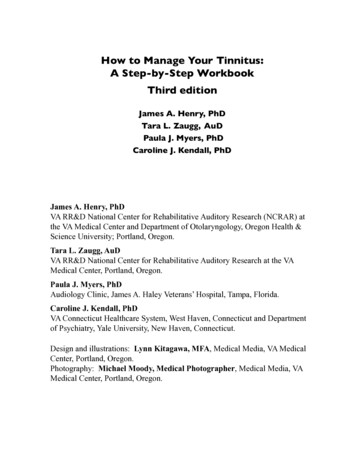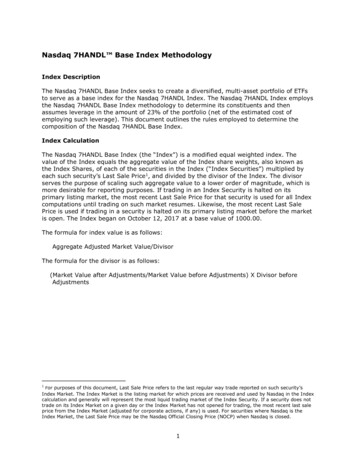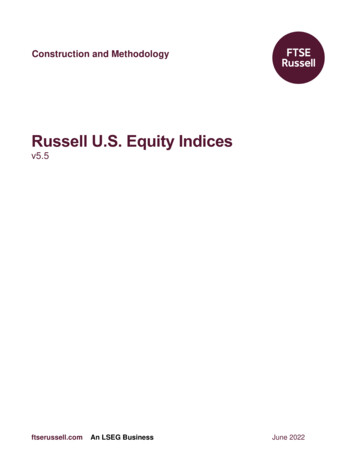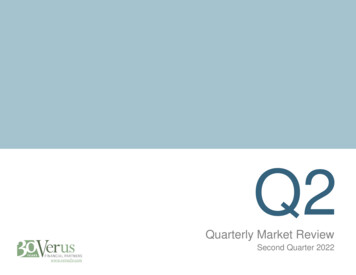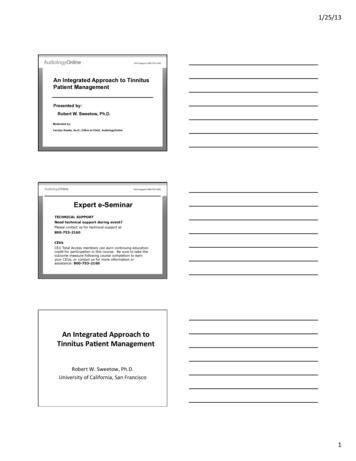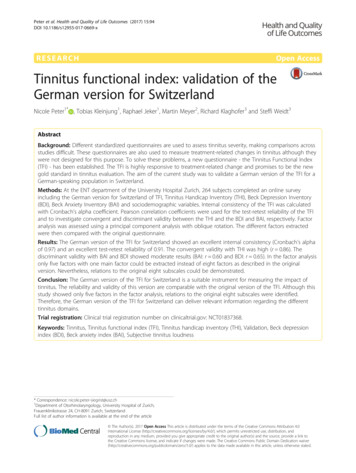
Transcription
Peter et al. Health and Quality of Life Outcomes (2017) 15:94DOI 10.1186/s12955-017-0669-xRESEARCHOpen AccessTinnitus functional index: validation of theGerman version for SwitzerlandNicole Peter1* , Tobias Kleinjung1, Raphael Jeker1, Martin Meyer2, Richard Klaghofer3 and Steffi Weidt3AbstractBackground: Different standardized questionnaires are used to assess tinnitus severity, making comparisons acrossstudies difficult. These questionnaires are also used to measure treatment-related changes in tinnitus although theywere not designed for this purpose. To solve these problems, a new questionnaire - the Tinnitus Functional Index(TFI) - has been established. The TFI is highly responsive to treatment-related change and promises to be the newgold standard in tinnitus evaluation. The aim of the current study was to validate a German version of the TFI for aGerman-speaking population in Switzerland.Methods: At the ENT department of the University Hospital Zurich, 264 subjects completed an online surveyincluding the German version for Switzerland of TFI, Tinnitus Handicap Inventory (THI), Beck Depression Inventory(BDI), Beck Anxiety Inventory (BAI) and sociodemographic variables. Internal consistency of the TFI was calculatedwith Cronbach’s alpha coefficient. Pearson correlation coefficients were used for the test-retest reliability of the TFIand to investigate convergent and discriminant validity between the THI and the BDI and BAI, respectively. Factoranalysis was assessed using a principal component analysis with oblique rotation. The different factors extractedwere then compared with the original questionnaire.Results: The German version of the TFI for Switzerland showed an excellent internal consistency (Cronbach’s alphaof 0.97) and an excellent test-retest reliability of 0.91. The convergent validity with THI was high (r 0.86). Thediscriminant validity with BAI and BDI showed moderate results (BAI: r 0.60 and BDI: r 0.65). In the factor analysisonly five factors with one main factor could be extracted instead of eight factors as described in the originalversion. Nevertheless, relations to the original eight subscales could be demonstrated.Conclusion: The German version of the TFI for Switzerland is a suitable instrument for measuring the impact oftinnitus. The reliability and validity of this version are comparable with the original version of the TFI. Although thisstudy showed only five factors in the factor analysis, relations to the original eight subscales were identified.Therefore, the German version of the TFI for Switzerland can deliver relevant information regarding the differenttinnitus domains.Trial registration: Clinical trial registration number on clinicaltrial.gov: NCT01837368.Keywords: Tinnitus, Tinnitus functional index (TFI), Tinnitus handicap inventory (THI), Validation, Beck depressionindex (BDI), Beck anxiety index (BAI), Subjective tinnitus loudness* Correspondence: nicole.peter-siegrist@usz.ch1Department of Otorhinolaryngology, University Hospital of Zurich,Frauenklinikstrasse 24, CH-8091 Zurich, SwitzerlandFull list of author information is available at the end of the article The Author(s). 2017 Open Access This article is distributed under the terms of the Creative Commons Attribution 4.0International License (http://creativecommons.org/licenses/by/4.0/), which permits unrestricted use, distribution, andreproduction in any medium, provided you give appropriate credit to the original author(s) and the source, provide a link tothe Creative Commons license, and indicate if changes were made. The Creative Commons Public Domain Dedication o/1.0/) applies to the data made available in this article, unless otherwise stated.
Peter et al. Health and Quality of Life Outcomes (2017) 15:94BackgroundTinnitus is an auditory perception of sound in the absence of a corresponding external acoustic stimulus.Chronic tinnitus is a frequently occurring condition withreported prevalence rates ranging from 2.4 to 20% [1].Although most people with tinnitus either cope with orhabituate to the acoustic stimulus and thus report it having no impact on their quality of life, some people sufferfrom more severe tinnitus and view it as a debilitatingcondition that affects their quality of life and causesthem to seek medical evaluation [2, 3].The lack of objective means for measuring tinnitus necessitates the use of self-report questionnaires for itsevaluation [4]. To this end, several psychometric questionnaires have been developed to assess the differentaspects of daily life that are affected by tinnitus, such assuch as concentration, sleep, emotional distress, tinnitusannoyance, and the quality of life in general. These questionnaires enable the evaluation of tinnitus severity: forexample, the validated Tinnitus Handicap Inventory(THI) categorizes the total score into five levels oftinnitus severity (slight, mild, moderate, severe andcatastrophic tinnitus) [5]. A problem, however, is thatthese questionnaires use different scaling, wording ofitems, and formatting, and have not been prospectivelyevaluated for assessing responsiveness, which makes itdifficult to compare the outcomes of different trials andto determine the effectiveness of the investigatedinterventions [6]. To overcome these shortcomings, theTinnitus Research Consortium (TRC) supported the development and evaluation of a new outcome measurefor tinnitus [7], with the aim of improving tinnitus research [7]. Consequently, Meikle et al. (2012) developedand validated the new Tinnitus Functional Index (TFI)at Oregon Health and Science University (OHSU) [7, 8].The TFI was developed to provide a scaling of tinnitusseverity, an identification of tinnitus domains with impact on the tinnitus severity, and a responsive measurement of change in tinnitus severity [8, 9]. By usingexploratory factor analysis, the tinnitus domains weredefined into eight different subscales (factors): intrusiveness, sense of control, cognition, sleep, auditory, relaxation, quality of life, and emotional distress [8, 9]. Since2012, the TFI has been translated into different languagesand these translated versions have been validated in several countries (e.g., Poland, Sweden, the United Kingdom,and the Dutch speaking population of Belgium) [2, 9–11].However, to our knowledge there is no validated Germanversion for Switzerland of the TFI. Such a version couldbe used as a standard instrument in both clinical andresearch settings due to the TFI’s responsiveness totreatment-related changes, its comprehensive coverage ofthe domains of tinnitus impact, and its other psychometric properties [8, 12, 13].Page 2 of 9The original version of the TFI had a Cronbach’s alpha of0.97 and a test-retest reliability of 0.78 [8, 10, 12, 13]. Furthermore, the convergent validity with the THI (r 0.86)and the Visual Analogue Scale (VAS) (r 0.75) showed ahigh correlation [8, 13], and the discriminant validityyielded good results with the Beck Depression Inventory(BDI) (r 0.56) [8, 13]. Moreover, the TFI was highly responsive to treatment-related change with a larger effectsize than that of the THI and VAS [8].The aim of this prospective study was to validate theGerman version for Switzerland of the TFI. To this end,the internal consistency and the factor structure of thetranslated TFI, as well as the convergent and divergentvalidity between the THI, the BDI and Beck AnxietyInventory (BAI), respectively, were analyzed.MethodsParticipantsThis study was a prospective, non-interventional, observational trial in patients suffering from tinnitus. Thestudy was approved by the ethical committee of theCanton of Zurich and was registered on clinicaltrial.gov(NCT01837368). All participants gave their electronicconsent by ticking a consent box before starting to answer the questionnaires online.From February 2014 until April 2016, 434 patients(176 female (41.0%)) with a primary complaint of tinnitus were asked in a personalized letter to participate inthe study. These patients were transferred to the department of Otorhinolaryngology at the University HospitalZurich for further investigation and possible treatmentoptions for their tinnitus. Four weeks before theirplanned consultation, these patients were then sent aletter requesting them to complete an online surveyconsisting of the TFI [8], THI [5], BDI [14], BAI [15],self-perceived tinnitus loudness, and their annoyanceabout the tinnitus. Of the 264 subjects who completedthe first online survey, 128 patients (every second patient) were randomly selected two to three weeks beforetheir consultation to complete a second survey that included only the TFI for the purpose of retesting.Patients were included in the study only if they reported having tinnitus for a minimum of one month,were fluent in the German language, at least 18 yearsold, and had sufficient computer skills to participate inan online survey.Out of the initial 434 patients, 264 (104 female(39.4%)) completed the first survey. Fifteen patients werenot included due to an insufficient knowledge of theGerman language and 155 patients declined to participate in the study. Out of the 264 subjects who completed the first survey, 128 were randomly selected andasked to answer the second survey. Eighty-six subjectscompleted the second survey within the accepted period
Peter et al. Health and Quality of Life Outcomes (2017) 15:94of a minimum of 7 and a maximum of 21 days betweenthe two surveys, and could thus be included in the testretest reliability analysis. In 13 subjects the period between answered questionnaires was too short and in 15subjects, too long. Fourteen patients did not answer thesecond survey.AssessmentThe TFI [8] is a newly-designed questionnaire for tinnitus assessment and treatment outcome measurement.The TFI consists of 25 items with a response option onan 11-point Likert scale from 0–10, with descriptors atboth ends of the scale. Questions 1 and 3 are exceptionsbecause they are expressed in percentages ranging fromzero to 100%. Before performing any calculation, theseanswers must be transformed onto a 0–10 scale. Theoverall TFI score is calculated by multiplying the meanof all answered questions by 10. A minimum of 19 questions have to be answered to calculate a valid overall TFIscore. As a result, the overall TFI score ranges from zeroto 100, independent of the number of answered questions. Based on data collected during the developmentof the TFI, the overall TFI score can be categorized intofive levels of tinnitus severity [12]: not a problem (0 to17), small problem (18 to 31), moderate problem (32 to53), big problem (54 to 72), very big problem (73 to100). Furthermore, the items can be grouped into 8 subscales: intrusiveness (Items (I): 1–3), reduced sense ofcontrol (I: 4–6), cognitive interference (I: 7–9), sleep disturbance (I: 10–12), auditory difficulties attributed to tinnitus (I: 13–15), interference with relaxation (I: 16–18),reduced quality of life (I: 19–22), and emotional distress(I: 23–25). The calculation of a subscale score employs thesame method as is equal to the calculation for the overallTFI score (i.e., the mean of answered questions in a subscale multiplied by 10) and ranges from zero to 100.The translation of the original English version into aGerman version of TFI for Switzerland was initiated byAuris Medical, a Swiss biopharmaceutical company, in cooperation with the Oregon Health & Science University(“OHSU”) using a translation-back translation procedureaccording to the “Principles of Good Practice for theTranslation and Cultural Adaptation Process for PatientReported Outcomes (PRO) Measures” [13, 16]. TheGerman version of TFI for Switzerland has been transferredinto an online version. To avoid several sequence effects inthe test construction [17], the items were randomized usingrandom.org (item order: 22, 14, 24, 23, 8, 18, 16, 4, 3, 6, 25,20, 13, 2, 21, 12, 19, 10, 7, 17, 11, 1, 15, 5, 9).To determine convergent validity for the TFI the THI[5], and as a discriminant validity the BDI [14] and theBAI [15], respectively, were assessed.The questionnaire used to assess the convergent validity, the THI [5], is an earlier instrument for tinnitusPage 3 of 9assessment. In our study we used the validated Germanversion with 25 questions [18]. Each question has threeresponse options: yes (4 points), sometimes (2 points),and no (0 points). Consequently, the THI total scoreranges from zero to 100.The BDI [14] and the BAI [15] were used to assess depressive and anxiety symptoms, respectively. Each questionnaire consists of 21 items with four response options(0 to 3) and has a total score ranging from zero to 63.Furthermore, the patients were asked to rate their selfperceived tinnitus loudness and their annoyance aboutthe tinnitus on an 11-point Likert scale from 0–10.Statistical analysisTo measure the reliability of the German version of theTFI for Switzerland, internal consistency was calculatedwith Cronbach’s alpha coefficient. Pearson correlationswere performed for all correlations and the test-retestreliability of the TFI. The convergent validity of the TFIcompared with THI, and the discriminant validity of theTFI with BDI and BAI was analyzed using Pearson correlation coefficients.For the factor analysis, Bartlett’s test of Sphericity andthe Kaiser-Meyer-Olkin (KMO) test were calculated toevaluate the appropriateness of a factor analysis [19]. Aprincipal component analysis with oblique rotation wasapplied to extract different factors. To determine thenumber of factors, two different criteria were used. First,the scree test consisting of a scree plot with eigenvalueson the Y-axis and component numbers on the X-axisTable 1 Demographic and clinical characteristics of 264patients with tinnitusMeanSDAge, years48.613.6TFI total score (0–100)40.6523.20THI total score (0–100)43.7923.99BDI total score (0–63)8.957.34BAI total score (0–63)10.539.38Duration of tinnitus, month72.5101.3Number of Patients%Gender, female/male104/16039.4/60.6Partnership, yes/no177/8767.0/33.0TFI Tinnitus severity categoriesNot a problem (0 to 17)4717.8Small problem (18 to 31)6022.7Moderate problem (32 to 53)7829.5Big problem (54 to 72)5018.9Very big problem (73 to 100)2911.0TFI Tinnitus functional index, THI Tinnitus handicap inventory, BDI Beckdepression inventory, BAI Beck anxiety inventory, Partnership: married andunmarried relationship
Peter et al. Health and Quality of Life Outcomes (2017) 15:94Page 4 of 9was applied. In this plot, all data points that are abovethe point of inflexion reflect the number of factors. Todetermine the point of inflexion, a horizontal line and avertical line starting from each end of the curve aredrawn [20]. Second, the Jolliffe’s criterion has a suggested cut-off for eigenvalues greater than 0.7 [21]. Thesignificance level was set at p 0.05 (two sided), unlessotherwise specified. SPSS (Statistical Packages for SocialSciences, version 23.0, SPSS Inc., Chicago, IL, USA) wasused for all statistical analyses.ResultsA total of 264 subjects were included in this study. Themean age of participants was 48.6 years ( 13.6 SD, range18–81 years), 104 (39.4%) were female, and the meanduration of tinnitus was 72.5 months ( 101.3 SD, range1–540 months). Further demographic and clinical characteristics are presented in Table 1.The distribution of the overall TFI scores is displayedin Fig. 1. Cronbach’s alpha of the TFI was 0.97 and thetest-retest reliability of the TFI was excellent with a reliability of 0.91 (both p 0.001). The convergent validityof TFI compared with THI total score showed a highcorrelation of 0.86 (p 0.001) and the discriminant validity of TFI when compared with BAI was 0.60, and0.65 with BDI (both p 0.001). The correlation ofthe overall TFI score with tinnitus annoyance was0.71, and 0.51 with self-perceived tinnitus loudness(both p 0.001).The Bartlett’s test of Sphericity was significant( 0.0001), indicating that the items of the TFI were correlated. A high KMO ratio of 0.96 for the TFI impliedthat a factor analysis should present distinct and reliablefactors. A principal component analysis with oblique rotation was applied and the resulting communalitiesranged from 0.50 to 0.95. The number of components ofthe TFI was defined based on the eigenvalues. The scree25Mean 40.65Standard Deviation 23.20Frequency20151050020406080Overall TFI Score from 0 to 100Fig. 1 Distribution, mean and SD of the overall TFI score. The frequency of a specific overall TFI score diagramed in 5 point steps100
Peter et al. Health and Quality of Life Outcomes (2017) 15:94Page 5 of 9plot showed a very sharp decline after the first factor(Fig. 2), and virtually drawn horizontal and vertical linesstarting from each end of the curve indicated that onlyone factor point was above the point of inflexion. However, by applying Jolliffe’s criterion, a five-factor structurecould be retained (Table 2) and these five factors explained 82.70% of the total variance. With reference tothe original TFI’s eight factors, a principal componentanalysis with oblique rotation and eight fixed factors wasperformed (Table 3). Although the eigenvalues of the lastfactors were smaller than 0.7, there were correlations between the items and their factors. Only Factor 8, standing for sense of control, was represented by only oneitem, number 4. Items 5 and 6 were also expected tocorrelate with this factor but did not. Rather, Item 6correlated strongly with Factor 1 (intrusiveness), andItem 5 did not correlate strongly with any factor. Inaddition, Item 22 correlated more strongly with Factor4 (cognitive interference) than the expected Factor 7(reduced quality of life).DiscussionThe German version of the TFI for Switzerland showedan excellent internal consistency (Cronbach’s alpha of0.97) similar to the English version (Cronbach’s alpha of0.97), and an excellent test-retest reliability of 0.91,which exceeds that of the original version (r 0.78) [8].The convergent validity with THI was high (r 0.86) andcomparable to the English version (r 0.75) [8]. Furthermore, the scores for tinnitus annoyance on the 11-pointLikert scale correlated strongly with the TFI (r 0.71).However, the correlation between self-perceived tinnitusloudness and the TFI was only 0.51. Rabau et al. [10]demonstrated correlations of a similar strength betweenVAS mean loudness and the TFI of 0.66, and VAS maximum loudness with the TFI of 0.59. Fackrell et al. [9]Scree Plot20Eigenvalue15105012345678910 11 12 13 14 15 16 17 18 19 20 21 22 23 24 25Component NumberFig. 2 Scree Plot of principal component analysis with oblique rotation. The scree plot showed a very sharp decline after the first factor. A virtuallydrawn horizontal and vertical line starting from each end of the curve indicated only one factor point above the point of inflexion
Peter et al. Health and Quality of Life Outcomes (2017) 15:94Page 6 of 9Table 2 Principal component analysis with oblique rotationItemFactor1 Cognitive, Quality of Life, Emotional2 Intrusive, Sense of Control3 Auditory4 Sleep5 1Initial Eigenvalue15.262.101.361.15.80% of variance61.068.415.444.603.20Cumulative %61.0669.4674.9079.5082.70Appling the Jolliffe's criterion (eigenvalues 0.7) five factors could be extracted. The correlations between each item and the five factors are shown. Theeigenvalues of each factor and its corresponding variance are also presented. The values less than 0.4 are italicfound an even weaker correlation between VAS loudnessand TFI of 0.46. Similarly, other studies have also foundthat the correlation of subjective tinnitus loudness withTHI was 0.5 [22, 23]. Nevertheless, Wrzosek et al. [11]showed a strong correlation between VAS loudness andTFI of 0.76, but also a weaker correlation with the THI of0.61. In the original version, Meikle et al. [8] demonstrateda strong correlation of 0.75 between VAS tinnitus severityand the TFI. A possible explanation for this discrepancycould be that the two scales of tinnitus loudness and tinnitus severity measure different aspects of tinnitus.The discriminant validity with BAI showed a moderateresult of 0.60. In the original version, the discriminant validity was calculated using the BDI (r 0.56) [8], and thisresult was slightly higher in our population (r 0.65).To follow, a factor analysis was performed to extract thedifferent factors of the TFI. The scree plot of the Germanversion indicated only one dominant factor with a higheigenvalue of 15.26 and all following eigenvalues 2.1.Nevertheless, using the Jolliffe’s criterion (eigenvalues 0.7),five factors could be extracted. Other studies have alsofailed to reproduce the original eight factor structure[2, 9–11]. For example, in the validation of the DutchTFI [10] 7 factors were found; for the Polish TFI [11], 5factors were identified when using a criterion for eigenvalues 1.0 (had they applied the Jolliffe’s criterion therewould have been 6 factors); and in the Swedish TFI [2] validation, 6 factors were extracted. The discrepancy betweenour study and the original version [8] could be due to therandomization of the items and the consequential
Peter et al. Health and Quality of Life Outcomes (2017) 15:94Page 7 of 9Table 3 Principal component analysis with oblique rotation with fixed eight factorsItemFactor1 Intrusive2 Auditory3 Sleep4 Cognitive5 Relaxation6 Emotional7 Quality of Life8 Sense of 51aInitial Eigenvalue15.262.101.361.15.80.61.53.48% of e %61.0669.4674.9079.5082.7085.1487.2789.18The correlations between each item and the fixed eight factors are shown. The eigenvalues of each factor and its corresponding variance are also presented.Although the eigenvalues of the last factors were smaller than 0.7, there are correlations between the items and their factors. Exceptions are the following threeitems (marked witha and as well in boldface): TFI 6, TFI 22, TFI 5. The values less than 0.4 are italicdisruption of the initial order sequence with the corresponding heading used in the original paper version. Toverify this hypothesis another German-speaking population should be tested with a non-randomized version.Of our extracted five factors, Factor 1 included threesubscales of the original TFI consisting of cognitiveinterference, reduced quality of life and emotional distress. This finding is not unexplainable because qualityof life has already been found to be associated with cognitive functions and emotional distress [24]. This interpretation is further supported by findings from thevalidation of the Dutch TFI, in which the subscales cognitive interference and reduced quality of life were summarized in one factor [10].To verify the eight subscales of the original TFI [8], afactor analysis with eight fixed factors was performed.Despite the fact that the eigenvalues of the last threefactors were smaller than 0.7, correlations between theitems and their corresponding factors could be demonstrated. Only the last factor, Factor 8 (sense of control),was represented by only one item, number 4. The otheritems which were expected to correlate with this factor,Items 5 and 6, did not. Item 5 did not correlate stronglywith any factor and Item 6 was strongly correlated withFactor 1 (intrusiveness). Interestingly, in the initial factoranalysis without eight fixed factors, the two factors intrusiveness and sense of control were in the same factor.Furthermore, Item 22 correlated more strongly with
Peter et al. Health and Quality of Life Outcomes (2017) 15:94Factor 4 (cognitive interference) than with the expectedFactor 7 (reduced quality of life). These two factors werealso summarized in one factor in the factor analysiswithout eight fixed factors.Overall, the results of this study are similar to thosefrom other studies validating the TFI in different languages [2, 10, 11]. To our knowledge, the current studyis the first to validate a German version for Switzerland ofthe TFI. In line with the Tinnitus Research Consortium’sintention that a new international outcome questionnairefor tinnitus symptoms be developed, the German TFI forSwitzerland is suggested here as a standard instrument forclinical and research settings. Despite these promising results, we have to acknowledge some limitations to ourstudy. First, as mentioned above, we chose to randomizethe items of the TFI. While we consider randomization tobe an appropriate method for avoiding several sequenceeffects in the test construction [17], this change may haveprevented us from replicating the original 8-factor structure. However, the exact impact that using a randomizedTFI had on the results remains unclear and further research is needed to investigate this issue. One possibilitywould be to compare two groups, one having completedthe original TFI and the other a randomized version of theTFI. A second limitation is that nearly 40% of patients refused to take part in the study. It is therefore not possibleto confidently exclude recruiting biases. However, the distribution between the sexes in the population of thosewho refused to take part in the study is similar (72 female(42.4%)) to that of the participants of our study. Furthermore, the demographic and clinical data show that ourpopulation, with a mean TFI of 40.65 and a standard deviation (SD) of 23.20, is almost identical to the investigatedpopulation in the United Kingdom ([9], mean 40.6, SD20.01). Further, compared to the populations of the original version ([8], mean 54.4, SD 24.7), the Swedish version ([2], mean 55.3, SD 19.9), and the Polish version([25], mean 46.7, SD 22.5), the population mean and SDin our study were lower. Nevertheless, a balanced distribution of the tinnitus severity measured by the TFI categories was demonstrated in our population. The refusal rateof 40% can be partly explained with reference to theincluding procedure. Even before the first consultation, potential participants were asked to participatein the test and retest. This was necessary because thefirst consultation in our clinic includes substantialpsychoeducation on tinnitus which had the potentialto influence the results. Third, although the assessedtest and re-test reliability were excellent, we did notinvestigate changes over time due to therapy. Therefore, we do not know how much change in the overall TFI score is required to be clinically significant inthe German-speaking population. Further studies areneeded to address this question.Page 8 of 9ConclusionTaken together, our study demonstrated that theGerman version of the TFI for Switzerland is a suitableinstrument for measuring the impact of tinnitus. The reliability and validity of this version are very good andcomparable with the original version of TFI [8]. Despitethe fact that in this study only five factors instead ofeight could be extracted, we demonstrated relations tothe original eight subscales. By this reckoning, theGerman version of the TFI for Switzerland can give relevant information about the different domains of tinnitus.Future studies should investigate (1) whether a nonrandomized questionnaire can more accurately replicatethe factor-structure of the original version, and (2) whichchange in the sum score of the questionnaire is requiredto be clinically significant in German-speaking Swiss tinnitus patients.AcknowledgementsWe acknowledge Auris Medical for initiating a translation of the TinnitusFunctional Index in cooperation with the Oregon Health & Science Universityinto a German version for Switzerland and would like to thank Thomas Meyerfrom Auris Medical and Michele Gunness from the Oregon Health & ScienceUniversity for providing us the license of this version. Furthermore, we thankLukas Horat and Melanie Koch for the assistance in the data-collection.FundingSW: University of Zurich – career development grant “Filling the gap”.Availability of data and materialsThe datasets generated and/or analyzed during the current study are notpublicly available due to the current law in Switzerland but are availablefrom the corresponding author on reasonable request and with permissionof the ethics committee of the Canton of Zurich.Authors' contributionsNP initiated the collaborative project, designed data-collection tools,collected data and monitored data collection for the whole trial, wrote thestatistical analysis plan, cleaned and analyzed the data, contributed to theinterpretation of data, drafted and revised the paper. SW initiated thecollaborative
at Oregon Health and Science University (OHSU) [7, 8]. The TFI was developed to provide a scaling of tinnitus severity, an identification of tinnitus domains with im-pact on the tinnitus severity, and a responsive measure-ment of change in tinnitus severity [8, 9]. By using exploratory factor analysis, the tinnitus domains were
